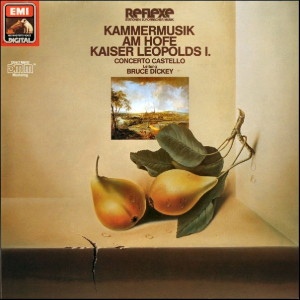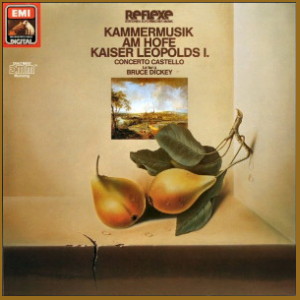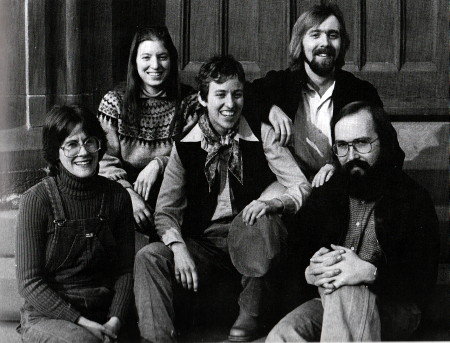 |
1 LP -
1C 069-1466971 - (p) 1983
|

|
| 1 CD - 8
26534 2 - (c) 2000 |
 |
| 1 CD -
CDM 7 63419 2 - (c) 1990 |
|
| KAMMERMUSIK AM HOFE KAISER
LEOPOLDS I. |
|
|
|
|
|
| Marco Antonio Ferro
(?-1662) |
|
|
| -
Sonata VIII à 4 (aus "Sonate
a due, tre e quattro op. 1, Venezia
1649") - Violino, Cornetto,
Trombone, Viola da gamba, Organo |
3' 29" |
|
| Johann Heinrich
Schmelzer (1623?-1680) |
|
|
| - Sonata VIII
à 2 - Violino, Viola da
gamba, Organo |
5' 32" |
|
| Johann
Jakob Froberger (1616-1667)
|
|
|
- Capriccio II
- Cembalo solo
|
3' 44" |
|
| Johann Heinrich
Schmelzer (1623?-1680) |
|
|
| - Sonata in G
à 4 detta la Carioletta - Violino,
Cornetto, Trombone, Fagotto,
Organo |
6' 10" |
|
|
|
|
| Johann Joseph Fux
(1660-1741) |
|
|
| -
Sonata in g à 4 K 347 - Violino,
Cornetto, Trombone, Fagotto,
Organo |
7' 55" |
|
| Johann Jakob
Froberger (1616-1667) |
|
|
- Toccata VI
- Cembalo solo
|
3' 20" |
|
| Johann Heinrich
Schmelzer (1623?-1680) |
|
|
| - Sonata in a
à 3 - Violino, Trombone,
Fagotto, Organo |
6' 21" |
|
| Marco Antonio Ferro
(?-1662) |
|
|
| - Sonata XI à
4 (aus "Sonate a due,
tre e quattro op. 1, Venezia 1649")
- Violino, Cornetto, Trombone,
Viola da gamba, Organo |
4' 40" |
|
|
|
|
CONCERTO CASTELLO
/ Bruce Dickey, Leitung
|
|
| aus Kopien von
Originalinstrumenten un mitteltöniger
Stimmung |
|
| - Bruce Dickey,
Cornetto |
|
| - Dana Maiben,
Violino |
|
| - Charles Toet,
Trombone |
|
| - Alice Robbins,
Viola da gamba |
|
| - Frances Fitch,
Organo & Cembalo |
|
| unter Mitwirkung von |
|
| - Claude Wassmer,
Fagotto (Choristfagott nach
Denner, Nürnberg ca. 1690 von
Laurent Verjart) |
|
|
|
|
|
Luogo
e data di registrazione |
|
Oude-Katholieke
Gem. v. Sinte Maria, Utrecht
(Olanda) - 24-27 novembre 1982 |
|
|
Registrazione:
live / studio |
|
studio |
|
|
Producer /
Engineer |
|
Gerd
Berg / Hartwig Paulsen
|
|
|
Prima Edizione
LP |
|
EMI
Electrola "Reflexe" - 1C
069-1466971 - (1 lp) - durata 41'
50" - (p) 1983 - DMM (Digitale) |
|
|
Prima Edizione
CD |
|
EMI
"Classics" - CDM 7 63419 2 - (1
cd) - durata 41' 50" - (c) 1990 -
DDD |
|
|
Edizione CD |
|
EMI
"Classics" - 8 26535 2 - (1 cd) -
durata 41' 47" - (c) 2000 - DDD |
|
|
Note |
|
- |
|
|
|
|
|
 In the
resplendent chronicle of the
orchestra (Hofmusikkapelle)
at the Hapsburg court in
Vienna, the Baroque period
represents one of the high
points. Of the Emperors of
this epoch - Ferdinand II,
Ferdinand III,
Leopold I, Joseph I and Karl
VI - all but the firstnamed
were themselves active as
composers and musicians. The
name of Leopold I is
associated in particular with
the expansion of operatic
activity at the Imperial
court; but the two other
categories of Baroque music -
church music and chamber (i.e.
secular non-dramatic)
music - also flourished under
his rule. In the
resplendent chronicle of the
orchestra (Hofmusikkapelle)
at the Hapsburg court in
Vienna, the Baroque period
represents one of the high
points. Of the Emperors of
this epoch - Ferdinand II,
Ferdinand III,
Leopold I, Joseph I and Karl
VI - all but the firstnamed
were themselves active as
composers and musicians. The
name of Leopold I is
associated in particular with
the expansion of operatic
activity at the Imperial
court; but the two other
categories of Baroque music -
church music and chamber (i.e.
secular non-dramatic)
music - also flourished under
his rule.
"...if
there was one thing in the
world that could not fail to
afford the Emperor
gratification, it was good
music. It increased his
pleasure, reduced his cares,
and one may say of him that
among all diversions he was
never better entertained than
at a well-arranged concert...
His orchestra can be called
the most perfect in the world,
and that is no wonder, since
the Emperor always set the
examination himself when a new
musician was to be engaged..."
This quotation from a lengthy
excursus on Leopold’s passion
for music from the pen of his
biographer Gottlieb Eucharius
Rinck, together with many
similar reports, shows that
Leopold’s musical court and
his own musical talents were
admired by contemporaries. No
wonder, then, that the
Viennese court became a centre
of attraction for competent
musicians, just as the court
for its part was always on the
look-out for outstanding
musical talents and was
willing to pay well for them.
A musician in the Emperor’s
employ could achieve a
considerable income - such
cases are documented; not,
however, by means of the
regular salary, which in any
case was often months or even
years in arrears owing to the
constant financial straits at
court. On the other hand there
were opportunities
to secure additional revenues
for extraordinary services
over and above one’s normal
duties. This official variety
of supplementary emolument was
not infrequently written into
the conditions of employment
from the outset (as was still
the case with Anton Bruckner).
Thus in 1667 Johann Heinrich
Schmelzer was able to apply
for special financial
consideration on account of
“the especial trouble taken
over the arias for festivities
and operas, since he could
otherwise put the time beyond
the fulfilment of his duties
to other gainful use". Similar
petitions from musicians -
particularly from such as were
unable to come by any source
of extra income - have
survived in great number: on
occasion sad evidence of real
privation, but important for
our knowledge of the social
status and way of life of the
musical profession.
These conditions of existence
were also of central
importance to the four
composers represented on this
recording, and are documented
accordingly. Marco Antonio
Ferro was lutenist to the
Imperial court from 1642.
Dismissed in 1651, apparently
for some aberration, he
addressed a request to the
Emperor in 1656 to “be so
gracious as to forgive him his
errors an receive him back
into the Hoff Capeln"
(sic). The Emperor only
cancelled hisinstructions “to
reject the supplicant" two
years later, and Ferro
returned to the court on 1st
October 1658. He died in this
post in 1662. The two
four-part sonatas recorded
here come from Ferro‘s only
known publication, a
collection of sonatas
dedicated to Emperor Ferdinand
III that
appeared in Venice in 1649.
The favour and disfavour of
the court were likewise
decisive factors in the life
of Johann Jacob Froberger. He
may have come to Vienna circa
1634, and was admitted to the
Hofkapelle as organist
on 1st December 1636. In the
following year, in accordance
with the usual practice, he
was able to travel to Rome
with the Emperor’s support to
study under the famous
Girolamo Frescobaldi. He seems
to have smoothed the way to
Rome for himself by requesting
the Emperor’s confessor “to
endeavour how he might convert
him to the Catholic religion,
with which he
had already made a start".
After his return he was back
in the service of the court
from 1st April 1641 to October
1645. He then appears to have
set out on travels again,
which we know took him to
Rome, Brussels, France and
England. Re-employed once
again as court organist on 1st
April 1653, he was dismissed
after Leopold ascended the
throne. He spent the last
years of his life in Héricourt
at the residence of Princess
Sibylla von Württemberg-Montbéliard,
who like him originally came
from Stuttgart. The Capriccio
and Toccata on this
recording survive in the
National Library in Vienna in
an autograph manuscript
dedicated to Ferdinand III “for
so many clement favours
bestowed on me without my
meriting them".
Johann Heinrich Schmelzer, one
of the most famous violin
virtuosi of the time, came
from the little town of
Scheibbs in Lower Austria,
where he was born circa 1623
as the son of an apparently
highly active father - he
appears as atanner, baker and
soldier! Schmelzer junior is
recorded as a musician in St
Stephan’s Church, Vienna, in
1643; on 1st October 1649 he
was engaged as a musician to
the court, where he was
appointed assistant
Kapellmeister in 1671 and
Hofkapellmeister (director of
music at the court) in 1679.
He died a year later, however
of the plague. He had been
given noble status in 1673. As
his above-mentioned petition
(not the only one of its kind)
proves - likewise his legacy
shows him to have been by no
means badly off - he knew how
to keep his head above water,
unlike many of his colleagues.
Since circa 1667 he had been
in contact with the
music-loving Bishop of Olmütz,
Karl von
Liechtenstein-Castelcorn; as
surviving letters prove, he
made himself available to the
Bishop as music advisor, and
repeatedly sent him
compositions on request -
certainly not without
remuneration. It is
to this situation that we owe
the survival of the three
sonatas recorded here, which
are preserved in the Bishop’s
music archive, now located in
Kremsier.
After Schmelzer, who was both
preand succeeded in the
position of Hofkapellmeister
by a long series of Italians,
the next native Austrian to
occupy the post was Johann
Joseph Fux. As Ferro and
Froberger had stood at the
beginning of the Leopold era,
and Schmelzer in the middle,
so Fux was active at its end.
He was engaged at the Hapsburg
court by an authoritarian
decision of Leopold’s that
by-passed the usual
bureaucratic procedures, and
he was even able - a rare
phenomenon - to hold his own
in both artistic and human
terms under the utterly
different personalities of
Leopold’s two sons, Joseph and
Karl. With Fux, as composer,
theoretician, teacher and
organiser of the music at
court an undisputed authority,
the Baroque breed of Hofkapellmeister
died out, and with his and
Karl VI’s
deaths the truly great era of
the Hofmusikkapelle
also came to an end. The
manner in which the sonata
a quattro K 347 was
preserved bears witness to his
fame: a pupil of Fux’s, the
Bohemian Jan Dismas Zelenka,
who worked in Dresden and was
sent from the Dresden court to
Vienna and Italy to study, put
together a manuscript
collection of well-known
pieces in Vienna in 1717/18,
in which this sonata appears
alongside other works by Fux.
One would like to believe that
Emperor Leopold I, whom music
accompanied all his life as an
innate need, also died to the
sound of music. Although this
is admittedly something that
is attributed to many rulers,
it would fit into the picture
of Leopold, and indeed of the
period as a whole, if in his
last hour, aware of his
tradition, he had ‘fallen into
line’, not least with the
thought that death represents
the entry into eternal
harmony.
Translation:
Clive R.
Williams
|
|
|
EMI Electrola
"Reflexe"
|
|
|
|

